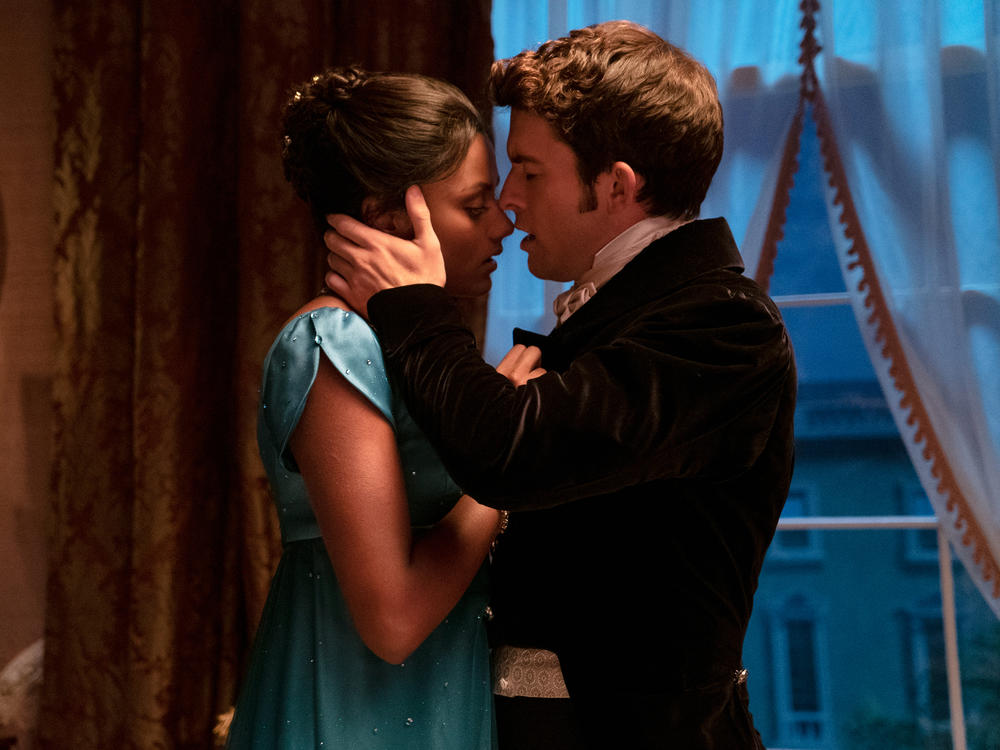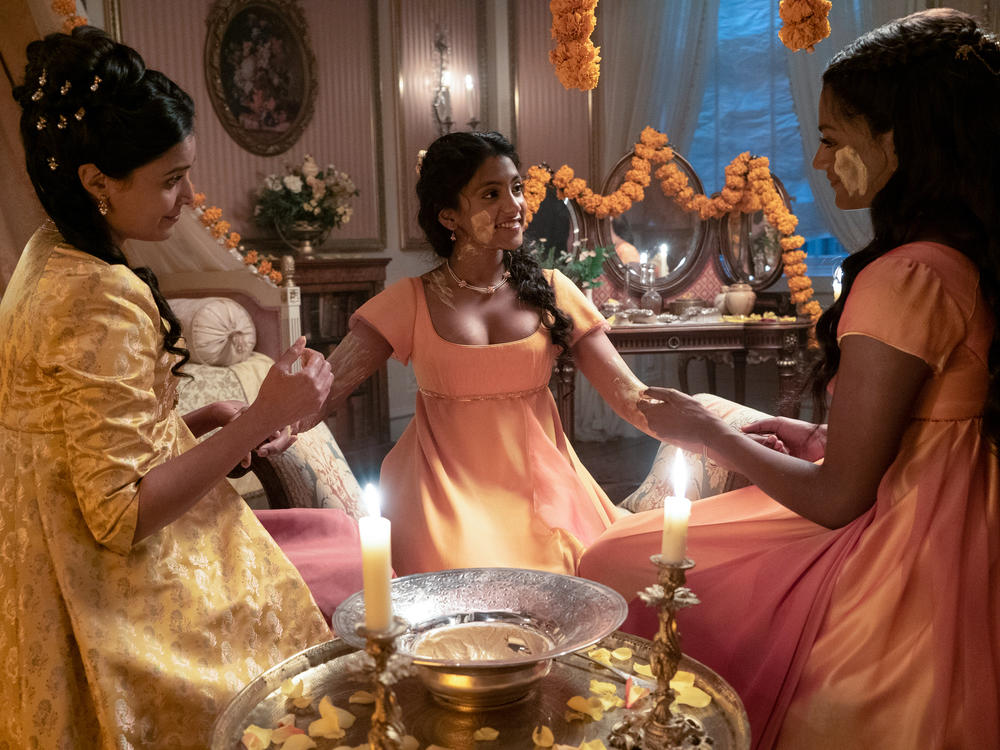Section Branding
Header Content
Two Indian half-sisters are the talk of 'Bridgerton' — and of modern-day India, too
Primary Content
Two brown-skinned women are the talk of 19th century England in the second season of the globally streaming Netflix hit series Bridgerton.
They're the talk of 21st century India as well.
They're Kate (played by Simone Ashley) and Edwina Sharma (Charithra Chandran), who arrive in the U.K. with their mother Mary in search of love and marriage.
In the Bridgerton universe, Mary is the daughter of the Earl of Sheffield and his Indian wife. We learn that when Mary was ready for marriage, she was declared a "diamond" by the queen (who bestows this title on eminently marriageable women to elevate their prospects).
But Mary made an unconventional choice. Instead of marrying a man with a title and wealth, she ran away to India with an ordinary Indian tradesman whom she's fallen in love with. He had a daughter — Kanthani (called Kate) — from a previous marriage. Mary's defiance and elopement humiliated her parents – not because she married a dark-skinned man but because she married outside of the upper crust of English society.
Now Mary is back in England after many years in India. Her husband has died. Her parents have promised to support her daughter Edwina and to grant her an inheritance — but only if she marries a man with a title.
True to the spirit of the "colorblind" casting in Bridgerton – a fantasy realm where no racial digs are heard – Mary and her children do not face any prejudices from the many white folk in the queen's court. Indeed, the beautiful Edwina, like her mom, is declared a "diamond" by Queen Charlotte (who herself is portrayed by a British-Guyanese actor).
So when characters on the TV series talk about the young women, it's because they are so strikingly beautiful and, in Kate's case, a radical spirit who dares to go riding on her own!
But in modern-day India, Bridgerton viewers are raising other topics in their heated discussion of the Sharma family: race and colorism and colonialism. And there's also much talk about the uncanny parallels between the 19th century women of Bridgerton, for whom marriage is absolutely critical, and women in the India of 2022.
Attention readers! At this point we must issue a spoiler alert because we need to bring up some plot points to fully address the reaction to Bridgerton in India.
Viewers are thrilled by Kate's skin tone
The color of Kate's skin is generating much comment.
"I've appreciated Bridgerton for their diverse casting right from Season 1. And I love that they chose a dark-skinned woman of Asian descent to play Kate," says Rumela Basu, 31, a writer based in the eastern Indian city of Kolkata.
Many Indian women on Twitter share Basu's views, talking about Kate's dark skin tone and striking good looks. Some note that in movies made in India, leading ladies are often fair-skinned, because Indian society considers lighter skinned women as a model of beauty-- even if it makes them look ethnically ambiguous. Many Indian women have a darker skin tone, more like Kate's.
There's also great appreciation for the show's depiction of Indian culture — in the distinctively Indian jewelry and exquisitely embroidered gowns in rich bold hues that are a hallmark of Indian fashion — eggplant purple, deep pinks and sky blues.
Bridgerton fans in India especially like the scenes where Kate criticizes the blandness of English tea (the Indian version called "chai" packs a spicier punch, so many Indians relate to her disdain) and her loving application of oil to her sister's hair to condition it (a common practice in India).
In the scenes before Edwina is set to marry Anthony Bridgerton (played by Jonathan Bailey), the Sharma girls are seen smearing turmeric paste on each other's cheeks. Called the 'haldi ceremony' this is a pre-wedding ritual in Hindu weddings, meant to bless the bride and give her glowing skin.
But all is not exactly on point in the Indian details
But all is not peaches and turmeric for Indian fans, who have raised some criticisms.
"It's bewildering how the Bridgerton team paid such close attention to these visual details, making identity and culture central to the plot and yet, still got many basic Indian references wrong", says Pratyasha Rath, 33, a consultant working in the development sector in Hyderabad. The mistakes, she feels, are absurd.
For instance, Kate refers to a musical instrument called "maruli," She's possibly referring to a flute, but that's called "murli" in Hindi.
Kate and her sister Edwina Sharma's facial features and deep tan skin tones are typically South Indian, and yet, their surname (which can reveal a lot in India) is typically upper caste and North Indian.
The sisters claim to speak Marathi, a language spoken in the western Indian state of Maharashtra, and yet, they refer to their late father as appa, a term used for father in Tamil, a southern Indian language. Kate calls her younger sister bon, but the closest equivalent to that is a word pronounced bone and it means younger sister in the language of Bengali, spoken in West Bengal, a state in eastern India. Edwina calls Kate didi, which means older sister in Hindi, spoken in many northern Indian states.
"When so much attention was paid to the costumes and jewelry, they should have fact-checked these basic details as well," says Pratyasha Rath.
For Pragya Agarwal, a behavioral and data scientist and Visiting Professor of Social Inequities and Injustice at Loughborough University in the U.K., the cultural mishmash reflects an attitude that "Indian-ness" is a homogenous, monolithic entity.
"It is easier for people to stereotype Indians without the awareness that India is a huge country with many different languages and cultural practices," she says. "Nevertheless, for second or third generation brown/Indian people, like my own children, it is so empowering to hear Hindi words on screen, beauty not being limited to fair skin and blonde hair and to see brown women as empowered, without the need to be passive or meek or talking about their past traumas."
And what about colonialism and interracial marriages?
But it does disturb her that the show seemed to gloss over the colonial presence – and how Indians were affected by imperialism in that period. "We are having conversations about how imperial history is being taught here in the U.K. now and it is easy to forget that [the series] is fantasy, not an accurate representation of the past," she says.
In reality, colonialism did affect India during the period in which Bridgerton is set but hadn't yet escalated into a bloody struggle; that came later, says Durba Ghosh, a professor in the history department at Cornell University.
"This (period) was before the uprising of 1857, which is often considered India's first war of Independence," she says.
Nonetheless, those earlier years saw the growing influence of the British East India Company, which is often likened to a ruthless conglomerate. It sowed seeds of discontent among native Indian rulers, which set the stage for discontent, oppression and colonialism.
As for the show's presentation of Brits and Indians getting married, that turns out to be true to life.
People of color were very much a part of the Regency era, when Bridgerton takes place. Many of them were the offspring of interracial marriages, says Ghosh, who is the author of Sex and The Family in Colonial India. "While it's impossible to say how many, there would have been South Asian aristocrats in these circuits as well. There are cases of [Indian] women who have traveled to Britain with their partners and who are a part of society and who have raised their children," she says.
According to Ghosh, the way those marriages frequently played out was a white British man marrying an Indian woman, so these mixed marriage families would have a father who would have been English and the mother of Indian descent, with a Europeanized last name. That is not the case with Sharma and her family, she notes.
Marriage then and now has its similarities
The show's depiction of aristocratic families navigating the politics of love and duty in London's competitive marriage market in the 1800s remind many Indian women of situations they've faced themselves.
In the first season of the show, when leading lady Daphne Bridgerton, the eldest of the Bridgerton daughters struggles to find a good suitor, she tells her brother on a moment of frustration, "You have no idea what it is to be a woman, what it might feel like to have one's entire life reduced to a single moment. This is all I have been raised for...If I am unable to find a husband, I shall be worthless."
Ghosh says the "marriage market" in Britain in this period (as depicted in Bridgerton) and in India today are very similar—"especially in the stakes for women." The pressure on women to wed even in the modern day is very real and often relentless. Marriage is seen by many sectors of society as a means to elevate a woman's social status, a means of security, even a duty one must perform for the sake of family honor.
Rumela Basu, the writer, says she comes from a progressive Bengali family, but there was a time three or four years ago, when she felt this pressure too. "Comments like 'if you do want to get married, you may as well do it at the right age,' were thrown my way, and every other person wanted to know when I was getting married," she says. "No matter that I'd gotten a pretty impressive job and was doing so many other things."
The independence of Kate Sharma has also struck a chord. In the very first scene, we see her breaking the rules—riding a horse on her own, unfettered and free, when most women needed to be chaperoned.
"I think Kate's independence is interesting," says Ghosh. "because she visualizes a future that's not resolved with marriage. It's something we're seeing girls pushing back against now in South Asian communities."
Just as Eloise Bridgerton, the second daughter of the family and a feminist once asked, "Why must our only options be to squawk and settle or to never leave the nest? What if I want to fly?"
Kamala Thiagarajan is a freelance journalist based in Madurai, Southern India. She reports on global health, science, and development, and her work has been published in the New York Times, The British Medical Journal, BBC, The Guardian and other outlets. You can find her on twitter @kamal_t
Copyright 2022 NPR. To see more, visit https://www.npr.org.
Correction
An earlier version of this story referred to Maharashtra as a northern Indian state. It is located in western India.



